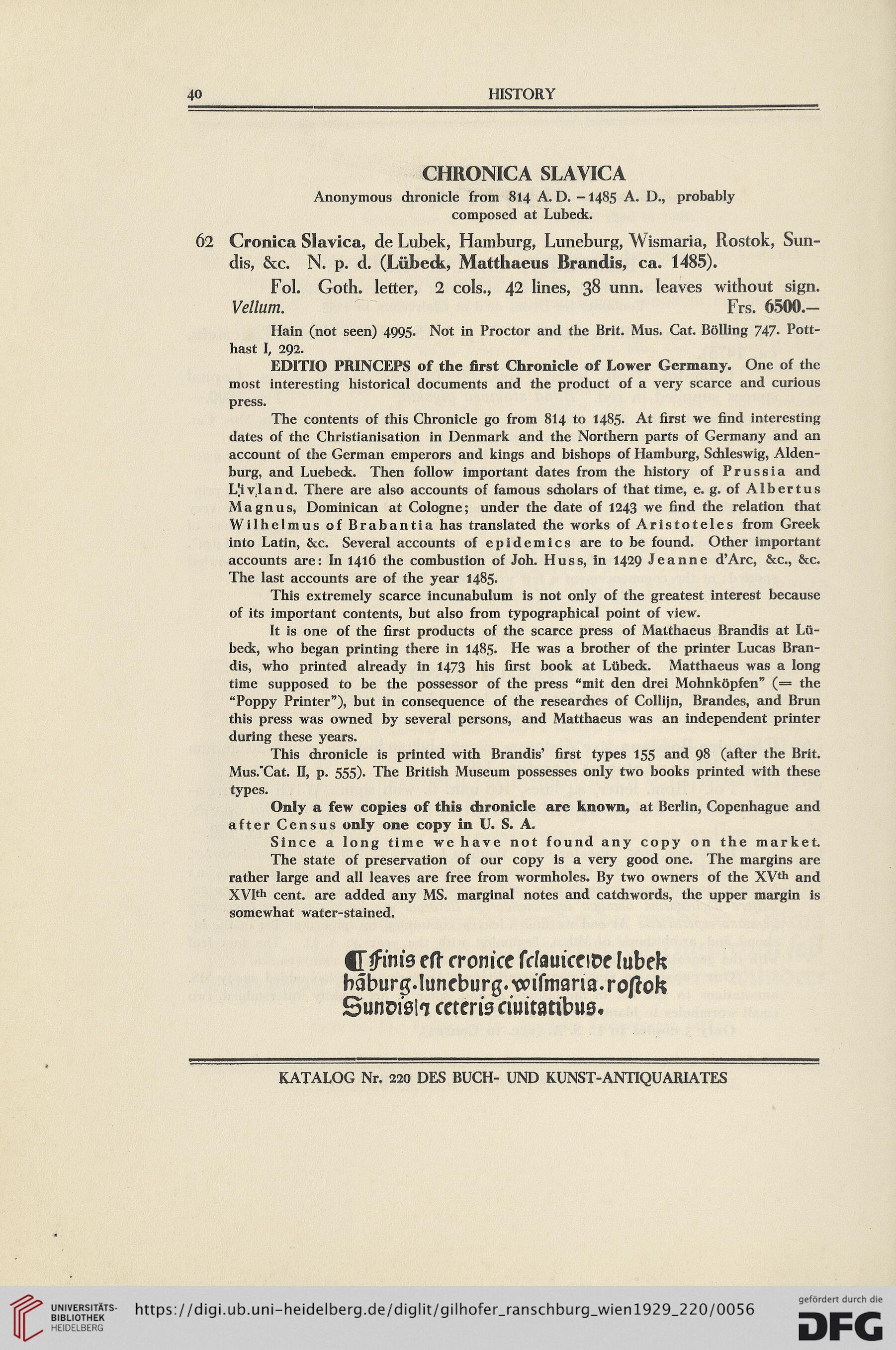40
HISTORY
CHRONICA SLAVICA
Anonymous dironicle from 814 A. D. -1485 A. D., probably
composed at Lubeck.
62 Cronica Slavica, de Lubek, Hamburg, Luneburg, Wismaria, Rostok, Sun-
dis, &c. N. p. d. (Lubeck, Matthaeus Brandis, ca. 1485).
Fol. Goth, letter, 2 cols., 42 lines, 38 unn. leaves without sign.
Vellum. Frs. 6500.—
Hain (not seen) 4995. Not in Proctor and the Brit. Mus. Cat. Billing 747. Pott-
hast I, 292.
ED1TIO PRINCEPS of the first Chronicle of Lower Germany. One of the
most interesting historical documents and the product of a very scarce and curious
press.
The contents of this Chronicle go from 8I4 to 1485. At first we find interesting
dates of the Christianisation in Denmark and the Northern parts of Germany and an
account of the German emperors and kings and bishops of Hamburg, Schleswig, Alden-
burg, and Luebedk. Then follow important dates from the history of Prussia and
L'ivland. There are also accounts of famous scholars of that time, e. g. of Albertus
Magnus, Dominican at Cologne; under the date of 1243 wc find the relation that
Wilhelmus of Brabantia has translated the works of Aristoteles from Greek
into Latin, &c. Several accounts of epidemics are to be found. Other important
accounts are: In 1416 the combustion of Job. Huss, in 1429 Jeanne d’Arc, &c., &c.
The last accounts are of the year 1485.
This extremely scarce incunabulum is not only of the greatest interest because
of its important contents, but also from typographical point of view.
It is one of the first products of the scarce press of Matthaeus Brandis at Lii-
beck, who began printing there in 1485. He was a brother of the printer Lucas Bran-
dis, who printed already in 1473 his first book at Liibeck. Matthaeus was a long
time supposed to be the possessor of the press “mit den drei Mohnkopfen” (== the
“Poppy Printer”), but in consequence of the researches of Collijn, Brandes, and Brun
this press was owned by several persons, and Matthaeus was an independent printer
during these years.
This chronicle is printed with Brandis’ first types 155 and 98 (after the Brit.
Mus.'Cat. II, p. 555). The British Museum possesses only two books printed with these
types.
Only a few copies of this dironicle are known, at Berlin, Copenhague and
after Census only one copy in U. S. A.
Since a long time we have not found any copy on the market.
The state of preservation of our copy is a very good one. The margins are
rather large and all leaves are free from wormholes. By two owners of the XVth and
XVIth cent, are added any MS. marginal notes and catchwords, the upper margin is
somewhat water-stained.
<nFmi0 eft- cronice fclauiceioe lubek
baburg.Iuneburg.-wifmana.ro/tok
Sunoislq ceteris ciuitatibus.
KATALOG Nr. 220 DES BUCH- UND KUNST-ANTIQUARIATES
HISTORY
CHRONICA SLAVICA
Anonymous dironicle from 814 A. D. -1485 A. D., probably
composed at Lubeck.
62 Cronica Slavica, de Lubek, Hamburg, Luneburg, Wismaria, Rostok, Sun-
dis, &c. N. p. d. (Lubeck, Matthaeus Brandis, ca. 1485).
Fol. Goth, letter, 2 cols., 42 lines, 38 unn. leaves without sign.
Vellum. Frs. 6500.—
Hain (not seen) 4995. Not in Proctor and the Brit. Mus. Cat. Billing 747. Pott-
hast I, 292.
ED1TIO PRINCEPS of the first Chronicle of Lower Germany. One of the
most interesting historical documents and the product of a very scarce and curious
press.
The contents of this Chronicle go from 8I4 to 1485. At first we find interesting
dates of the Christianisation in Denmark and the Northern parts of Germany and an
account of the German emperors and kings and bishops of Hamburg, Schleswig, Alden-
burg, and Luebedk. Then follow important dates from the history of Prussia and
L'ivland. There are also accounts of famous scholars of that time, e. g. of Albertus
Magnus, Dominican at Cologne; under the date of 1243 wc find the relation that
Wilhelmus of Brabantia has translated the works of Aristoteles from Greek
into Latin, &c. Several accounts of epidemics are to be found. Other important
accounts are: In 1416 the combustion of Job. Huss, in 1429 Jeanne d’Arc, &c., &c.
The last accounts are of the year 1485.
This extremely scarce incunabulum is not only of the greatest interest because
of its important contents, but also from typographical point of view.
It is one of the first products of the scarce press of Matthaeus Brandis at Lii-
beck, who began printing there in 1485. He was a brother of the printer Lucas Bran-
dis, who printed already in 1473 his first book at Liibeck. Matthaeus was a long
time supposed to be the possessor of the press “mit den drei Mohnkopfen” (== the
“Poppy Printer”), but in consequence of the researches of Collijn, Brandes, and Brun
this press was owned by several persons, and Matthaeus was an independent printer
during these years.
This chronicle is printed with Brandis’ first types 155 and 98 (after the Brit.
Mus.'Cat. II, p. 555). The British Museum possesses only two books printed with these
types.
Only a few copies of this dironicle are known, at Berlin, Copenhague and
after Census only one copy in U. S. A.
Since a long time we have not found any copy on the market.
The state of preservation of our copy is a very good one. The margins are
rather large and all leaves are free from wormholes. By two owners of the XVth and
XVIth cent, are added any MS. marginal notes and catchwords, the upper margin is
somewhat water-stained.
<nFmi0 eft- cronice fclauiceioe lubek
baburg.Iuneburg.-wifmana.ro/tok
Sunoislq ceteris ciuitatibus.
KATALOG Nr. 220 DES BUCH- UND KUNST-ANTIQUARIATES



